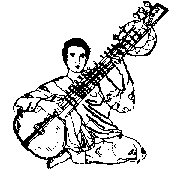Sitar
Accessories
















 for kids
for kids








Stringing a Sitar
I have created a couple of new instructional videos that walk you through some of this process. Video #1 is titled "Changing Your Sitar Strings" and Video #2 is titled "Tweaking Your Sitar" they are the first two in a 3 part series on Maintaining your sitar's peak performance.I got stung again!
It's February 5, 1998. I am tweaking one of my brand new sitars, getting it ready for sale. Without any warning ..... Ouch, that hurts! I try to tune my sitar and suddenly I get a terrible sting from a wire that has been left dangling from either the tuning peg or while I'm trying to fine tune with a bead behind the main bridge. It's like a sharp needle, it pokes you and it is a horrible feeling ..... I will implore you all to sit down today with your instruments and a sharp pair of wire cutters and cut off some of these needle points. If you have come to avoid this sting then take pity on the possibility of a friend, or a child making the same mistake and yelling out in pain. The worst side of this is that if a steel string is rusted it can be poisoness.How many times have I experienced this? Enough times so that I am a bit ticked off. I will implore all the manufacturers and dealers of sitars to please do a good job of stringing the instruments!
I have strung the sitar more times than any of you can imagine. Since I was 12, I have taken care of all my father's string instruments. That included learning (sometimes the hard way) about putting strings on an instrument and tweaking it. I have had my share of bad jobs (quite a few as a matter of fact). But the thing I have learned from this is that all you need is a little patience and a wire cutter. It just takes a few minutes and you have a well manicured sitar. This is why I cannot understand how many instrument delears can sell their instruments and not put any effort into tweaking the instruments to feel and sound their best. The payback is enormous in terms of goodwill and satisfaction. Don't, give us a bad or a sloppy job of re-stringing any stringed instrument.
Here are some of the things you need to keep in mind when re-stringing your sitar.
- mark the position of your bridge prior to cutting off the strings
- Replace one string at a time
- Make good tight anchor loops at one end of the string
- Have a wire cutter handy
- Always put the end of the string twice in the tuning peg.
- Remove the excess slack form each string after installation
- Tune your sitar
I will teach you to make the best loops for your instrument. It takes a little patience and a little practice to get the perfect loops. But the rewards are many. Amongst them are no "ouches" and your sitar will stay in tune.
Mark the position of the main and the sympathetic bridges
Many newbies will forget to do this. The result, your frets don't sound in tune anymore! Don't trust the old marks your bridge might have made when the instrument maker first set the bridge. This is usually wrong. And I just can't figure out why this is so. You'd think that someone capable of making such a fine instrument would align the bridge and frets to the proper intonation prior to shipping??? Oh well.....
Replace one string at a time
I remember when I replaced the spark plugs in my car for the very first time..... In my enthusiasm I took out all the wires and the plugs without marking them. When I put in the new ones I forgot whick ignition wire goes where.... the result .... a car that wouldn't start! I had to pay a mechanic more money than I saved to fix the problem!Expect this chaos if you do what I did when changing sitar strings. Pegs can get mixed up and you'll find that they don't fit in the holes as well as they did. The proper way is to replace one string at a time or, if you want to remove all of them, mark them well.
Make good tight anchor loops at one end of the string
Looping is no secret. But you have to have some practice. Coupled wth this is the fact that you might seem a bit clumsy at first but as you get more at home with handling strings this job gets easier. Remember strings, especially steel ones, are fine and slippery. In the sense that as you twist them to make a loop, the end section can, without warning, slip and end up in your hand or finger. So be very careful. An easy way to aviod this mishap is to take a larger string section to loop. Here are some diagrams explaining the looping for anchoring the string.


Have a wire cutter handy
Go buy a really good wire cutter. I have tried working with the cheapest and believe me it's not worth the hassle of saving a few dollars. A finely crafted cutter is sharp from the tip to the end. But don't trust a brand. Hold the cutter up to the light. There should be no gaps between the cutting blades. A quality wire cutter will also last much longer. Also find one that cuts the string flush. Some of the cutters have a beveled edge and hence will leave a bit of wire protuding. This can result in minor puncture wounds to you.
Other Issues:
1 • 2 • 3 • 4 • 5 • 6 • 7 • 8 • 9
|
